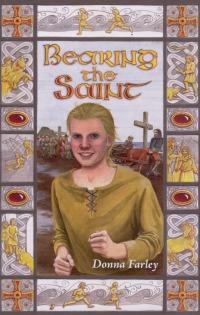| ________________
CM . . . . Volume XVII Number 12. . . .November 19, 2010. 
 |
Bearing the Saint.
Donna Farley.
Ben Lomond, CA: Conciliar Press, 2010.
261 pp., pbk., $16.95.
ISBN 978-1-936-2700-4-0.
Grades 7 and up / Ages 12 and up.
Review by Ruth Latta.
***/4
|
| |
|

excerpt:
Edmund felt he was drawn in somehow to the deep workings of creation. All these tiny figures connected to each other were like a great chorus of creatures singing the praise of the Creator, and every drop of coloured ink like a musical note. The Gospel book brimmed full of a great teeming mysterious dance that was yet the calmest, stillest thing he had ever seen.
Edmund is a youth living in 875 A.D. in present day Southeastern Scotland/Northeastern England, then known as "Northumbria." Being a fast runner, he is a messenger for Bishop Eardwulf. He has conflicts with his elder brother, Henred, who, following their father's drowning, has been called home from monastic life to support the family.
A constant presence in Edmund's life and that of his neighbours is the monastery on the island of Lindisfarne (a real place now known as "Holy Island.") In 676 A.D., the missionary and church leader Cuthbert settled in the Farne islands to lead the life of a hermit. Later. he was made Bishop of Lindisfarne and was buried there. Eventually, in the 10th century A.D., his remains were laid to rest permanently in Durham Cathedral.
Lindisfarne is also significant for the Lindisfarne Gospels, an illuminated manuscript created in the 800s which is now in the British Museum. Edmund is referring to it in the passage quoted above.
Edmund and his people are constantly under threat of Viking (Danish) invasion."The Danes loved to raid the undefended monasteries of the Angle and Saxon kingdom," writes author Donna Farley, "seizing the golden treasures made to beautify the church and capturing slaves to sell in far-off lands."
When a Danish attack is imminent, the bishop, abbot and reeve issue a call to action. They decide that everyone will flee from the monastery, taking with them St. Cuthbert's earthly remains and the Lindisfarne Gospels. Most of the villagers join this exodus. In her historical notes at the end of the novel, Farley explains that Symeon of Durham wrote about this period of wandering in Libellus de Exordio (a book from the 11th century A.D.) Symeon listed four coffin attendants by name: Franco, Stitheard, Hunred and Edmund. Clearly, Farley has delved deeply into the past to create a unique "road story." The main themes are the importance of spirituality in facing life's challenges and the possibility of peace coming out of ethnic and religious conflict.
Encounters with inclement weather, wolves, inhospitable impoverished countrymen and Danish warriors and settlers keep the plot lively. Farley's skill in smoothly incorporating her research is impressive. Skilfully, she conveys information about another culture through carefully chosen words, phrases and dialogue. A lesser author might have resorted to an "information dump," a mini-lecture in mid-story, which slows the pace and makes readers feel they are back in school. Farley avoids this pitfall.
Although Farley is a Word Guild award winner for Canadian Christian fiction, and although her publisher, Conciliar Press of California, is committed to publishing books with a "Christian Orthodox world view," there is no proselytizing in Bearing the Saint. The novel simply takes the reader with Edmund through an exciting adventure.
The idea of carrying a coffin of earthly remains through the wilderness jarred on me at first. Then I thought of the many stories involving pilgrimages to take loved ones' ashes to scatter in special places. (Graham Swift's Last Orders is an example.) If Farley had told us more about St. Cuthbert at the beginning, though, readers might more easily comprehend the emotional attachment of Edmund and the others toward this remarkable historical figure.
Searching the internet, I learned much about this fascinating person who lived and died approximately two hundred years before Bearing the Saint takes place. I read of his generosity to the poor, his gifts of healing, and his closeness to nature. He passed laws protecting eider ducks and other seabirds nesting on the Farne Islands! (http://en.wikipedia.org/wiki/Cuthbert_of_Lindisfarne) Long after his death, St. Cuthbert's influence continued. In medieval times, when the area around Durham was semi-autonomous, the inhabitants defined themselves as haliwerfolc, or "people of the saint." Some information along these lines would help readers understand why St. Cuthbert is so special to Edmund and his neighbours.
Farley has published a children's picture book, The Ravens of St. Cuthbert. I would enjoy reading a full-length novel about Cuthbert's earthly ministry. Meanwhile, Bearing the Saint is an impressive accomplishment.
Recommended.
Ruth Latta's most recent book is Winter Moon, a collection of short stories (Ottawa, Baico, 2010) Ruth blogs at http://ruthlatta.blogspot.com

To comment on this title or this review, send mail to
cm@umanitoba.ca.
Copyright © the Manitoba Library Association. Reproduction for personal use is permitted only if this copyright notice is maintained. Any other reproduction is prohibited without permission.
NEXT REVIEW |
TABLE OF CONTENTS FOR THIS ISSUE- November 19, 2010.
AUTHORS |
TITLES |
MEDIA REVIEWS |
PROFILES |
BACK ISSUES |
SEARCH |
CMARCHIVE |
HOME |
